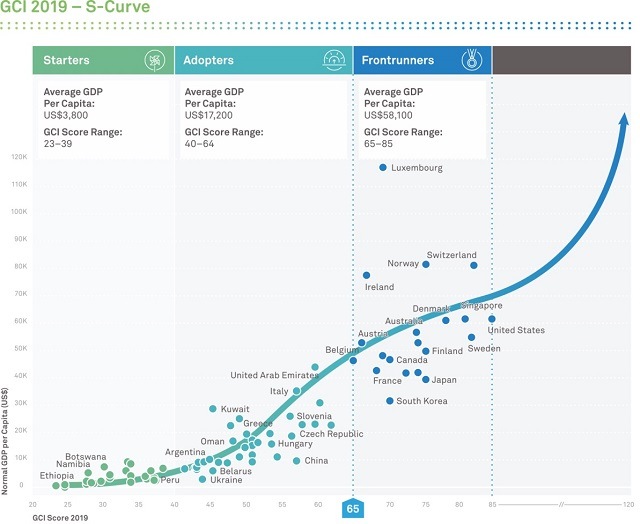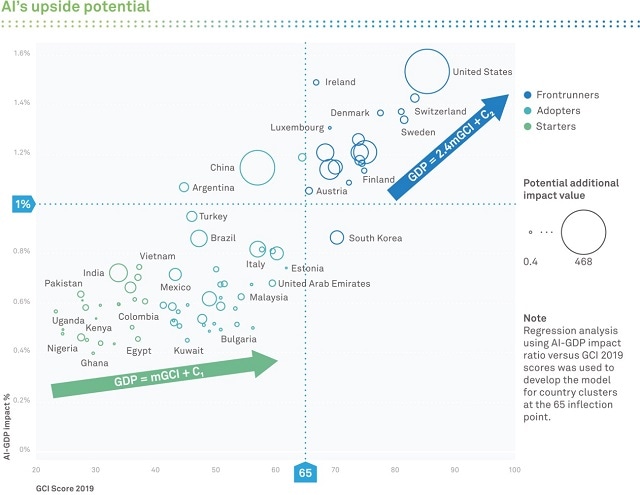• Intelligent Connectivity Is the Catalyst for Fresh GDP Growth, According to Huawei Global Connectivity Index 2019 Report
As AI-infused Intelligent Connectivity begins to have a meaningful impact on the digital economy and sparks a tipping point for digital transformation, a key finding of Huawei’s GCI 2019 is that countries with GCI scores over 65 that have made continuous investment in Intelligent Connectivity can expect it to boost GDP by more than 1%. At the same time, success in the era of intelligence depends on the ability to collaborate on a global scale.
Now in its sixth year, GCI 2019 highlights AI’s role as one of four key enablers that drive “Intelligent Connectivity”, alongside Broadband, Cloud, and IoT. All four have the potential to be significant catalysts for economic growth.
A new tipping point for national digital transformation
In 2016, the GCI identified the inflection point for emerging markets. When a country scores 35 points in the index, it crosses the threshold beyond which there is a multiplier effect of GDP growth against ICT investment. GCI 2019 found that the stimulus effect of the inflection point was giving a bump to countries on the top of the GCI S-curve as well. For countries with a GCI score of over 65, the S-curve starts to steepen once again. These countries are moving into a new growth cycle. Countries with the highest GCI scores can leverage Intelligent Connectivity to accelerate economic growth up to 2.4 times faster than other nations for every point of GCI improvement.

The upside potential of AI can stimulate economic growth
It is not just developed economies that can benefit from Intelligent Connectivity. GCI 2019 finds that nations at every level of digital development can access the “upside potential of AI” as a GDP booster when it is deployed by industries and organizations.
Even for Frontrunners like Japan and the US that have leading ICT infrastructure, the potential of AI has only just begun to be tapped. Adopters and Starters like China, Malaysia, India, the Philippines, and Spain aren’t spinning their wheels, either. They’re rolling out AI technologies as fast as they can.

Powering Intelligent Connectivity with global collaboration
GCI 2019 also identifies another way that Starter and Adopter nations can stimulate greater economic success: global collaboration. Because Intelligent Connectivity relies on global ecosystems to flourish, GCI 2019 identifies five stakeholder roles that can collaborate across domains to break down organizational silos and deliver fast business results: Decision Makers, Data Scientists, Data Collectors, ICT Companies, and End Users.
Whatever a country’s level of digital development, policymakers need to look objectively at the strengths of their national economy and determine how they can fit into and profit from the Intelligent Connectivity ecosystem.
We’re now seeing that the fusion of 5G, AI, and cloud has redefined connectivity, said Kevin Zhang, the CMO of Huawei ICT Infrastructure. Intelligent Connectivity is speeding up the development of the digital economy, so governments and industry leaders in Starter and Adopter nations should embrace new technologies, prioritize work on national-level digital transformation plans, and benefit from global collaboration. Meanwhile, we’ve realized that Intelligent Connectivity may be the answer to many of the societies’ most complicated and deeply rooted challenges, including climate change and the wealth gap between rich and poor. Huawei is committed to increasing efforts to make technology, applications, and skills accessible to everyone, and bringing Intelligent Connectivity’s benefits to every person, home and organization.
The GCI is designed to provide actionable insights for how policy makers and economic stakeholders can foster greater success in the digital economy. The 79 countries assessed by GCI 2019 account for 95 percent of global GDP and 84 percent of the world’s population.
• For more on the Global Connectivity Index 2019, visit here : www.huawei.com/minisite/gci/en/






















